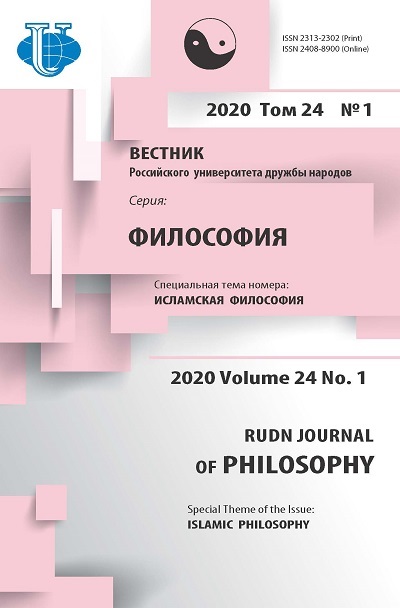The Study of the Principles of Philosophy of Islamic Art
- Authors: Hasti S.1
-
Affiliations:
- University of Exeter
- Issue: Vol 24, No 1 (2020): ISLAMIC PHILOSOPHY
- Pages: 23-38
- Section: ISLAMIC PHILOSOPHY
- URL: https://journals.rudn.ru/philosophy/article/view/23089
- DOI: https://doi.org/10.22363/2313-2302-2020-24-1-23-38
Cite item
Full Text
Abstract
The main discourse on Islamic art in the western academia primarily views Islamic art through the lens of art history and sociology of art. Islamic art is considered as sacred in Islamic civilisation and culture, and derives its sanctity from the Quran as the fountain from which it has emanated, which Muslims consider to be the Word of God, much like Christ is the Word of God in Christianity. The Quran has played a formative role in shaping the trinity of sacred Islamic art which is Quranic recitation, calligraphy and architecture. However, another approach which not only is viable but can be considered of great importance to the study of Islamic art, is the employment and utilisation of principles of Islamic philosophy and Sufism which were the pillars of the intellectual milieu in which a given work of art is produced. The application of such principles allows a more comprehensive and detailed interpretation of a work of art. In this paper, the primary Islamic philosophy and sufi doctrines that will be discussed are the concepts of imagination, colour, and calligraphy and examples of their application in the khānqāh and shrine ensemble of Shaykh Ṣafi al-Din Ardabīlī in Ardabil, Iran.
About the authors
Safavi Hasti
University of Exeter
Email: hasti.s@gmail.com
postgraduate student in the University of Exeter, graduate from the School of Oriental and African Studies of the University of London Stocker Road, Exeter, United Kingdom, EX4 4PY
References
- Ibn Sīnā. Tarjum-i va Sharḥ-i Ilāhiyāt-i Nijāt-i Shaykh al-Raʾis Abū Alī Sīnā. Y Yasribī, trans. Qum: Būstān-i Kitāb-i Qum; 1385 Sh/2006. (In Persian)
- M Quṭb al-Din Shīrāzī. Sharḥ-i Ḥikmat al-Ishrāq Suhrawardī. A Nūrānī, M Muḥaqiq, eds. Tehrān: Anjoman-i Tārīkh va Mafāsir-i Farhangī; 1379 Sh/2000. (In Persian)
- D Qayṣarī. Sharḥ-i Fuṣūṣ al-Ḥikam. Vol. 1. Tehrān: Intishārāt-i Mawlā; 1387 Sh/2008. (In Persian)
- Ibn ʿArabī. Fusūs al-Ḥikam. M Khājavī, trans. Tehrān: Mawlawī; 1393 Sh/2014. (In Persian)
- Ettinghausen R, Grabar O, Jenkins-Madina M. Islamic Art and Architecture 650-1250. New Haven and London: Yale University Press; 2001.
- The Study of Quran, SH Nasr, trans. New York: Harper Collins; 2015.
- Safavi H. Philosophy of Islamic Art and Architecture: Sheikh Safi al-Din Ardabili’s Khanqah and Shrine Ensemble & Gawharshad Mosque in Mashhad. London: London Academy of Iranian Studies Press; 2018.
- Kubrā N. Nasīm-i Jamāl va Dibāchi-yi Jalāl. Q Ansārī, trans. Tehrān: Tahūrī, 1388 Sh/2009. (In Persian).
- Rāzī N. Mirṣād al-ʿIbād min al-Mabdaʿ ila al-Maʿād, 13th Ed. Tehrān: Shirkat-i Intishārāti ʿIlmī va Farhangī; 1387 Sh/2008. (In Persian)
- A Simnānī. al-Orwa li-ahl al-khalwa va al-jelva, edited by N Māyil Hiravī. 2nd Ed. Tehrān: Intishārāt-i Mawlā; 1395 Sh/2016. (In Persian)
- The Meaning of the Glorious Qur’an. Al-Baqarah: The Cow. Sacred Texts website. https://www.sacred-texts.com/isl/pick/002.htm. Accessed July 5th, 2018.
- Ṭabāṭabāyi MH. al-Mizān fi Tafsīr al-Qurān. Site Shahīd Āvīnī. http://www.aviny.com/quran/almizan/jeld-1/mizan-11.aspx. Accessed July 5th, 2018. [In Persian].
- Qushayrī AQ. Laṭāʿ’if al-Ishārāt. Cairo: al-Hiy’at al-Miṣrī-ya al-Āmma lī al-Kitāb; 2000. (In Persian)
- Corbin H. Man of Light in Iranian Sufism. Nancy Pearson, trans. New York: Omega Publications Inc; 1994.
- Rumi MJ. The Mathnawi. RA Nicholson, trans. London: Luzac; 1971.
- Sabzivarī HM. Sharḥ-i Asrār-i Mathnawī Maʿnavī. Vol. 1. Tehrān: Vizārat-i Farhang va Irshād-i Islāmī; 1371 Sh/1992. (In Persian)
- Lings M. Symbol & Archetype: A Study of Meaning of Existence. Kentucky: Fons Vitae; 2006.
- Schimmel A. The Mystical Dimensions of Islam. Chapel Hill: The University of North Carolina Press; 1975.
- [Schimmel A, Rivolta B. Islamic Calligraphy. New York: Metropolitan Museum of Art; 1992.
- Schimmel A. Calligraphy and Islamic Culture. London: I.B. Tauris & Co Ltd; 1990.
















